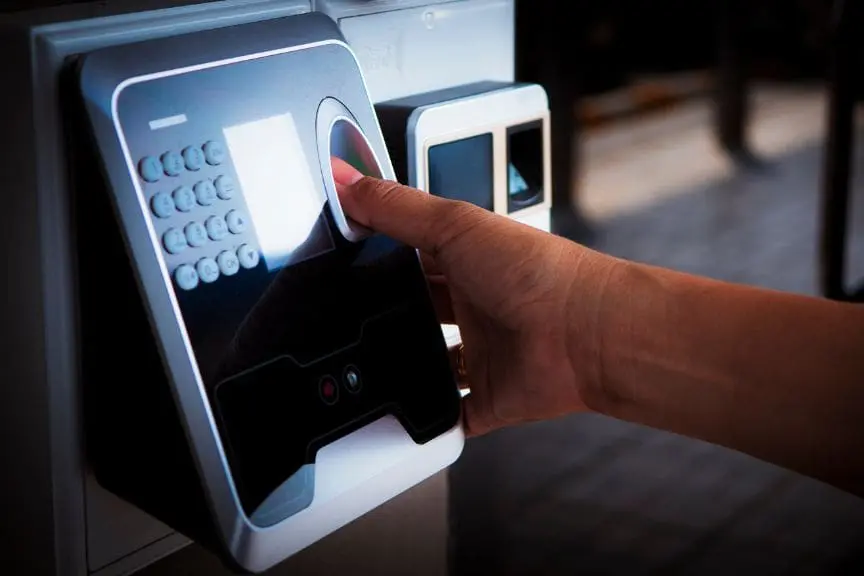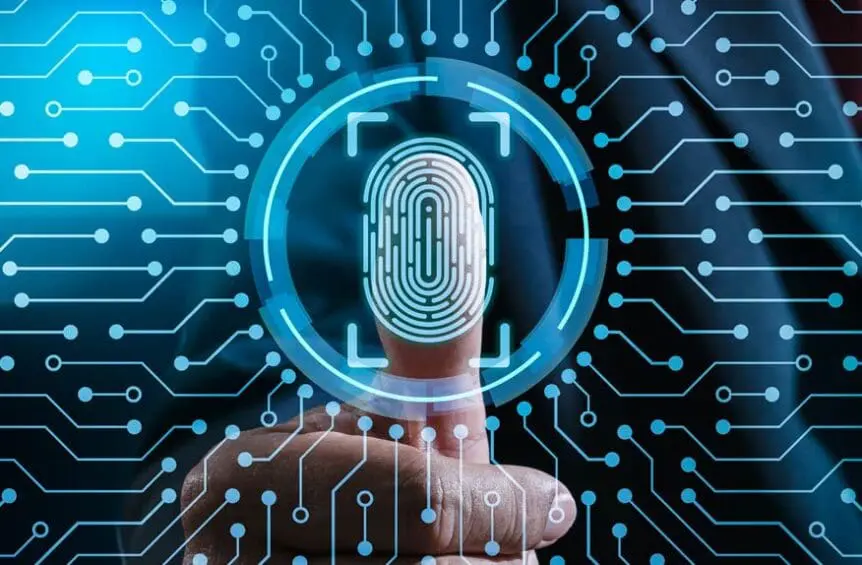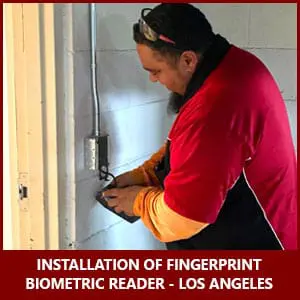
Jake Pflaumer
National Hardware Expert
jakep@flyinglocksmiths.com
Biometric technology has revolutionized the way businesses approach their access management, as these sophisticated systems have played large roles in the evolution of physical security. These sophisticated access systems use unique physical traits, including fingerprints, iris patterns, and facial features to authorize entry, making it difficult for unauthorized users to gain access. This advanced form of entry creates an extra layer of protection for individual users and large workforces, providing more accessible and safe work environments.
Biometric access control systems present numerous benefits for businesses, as these keyless entry systems deliver convenient entry for approved personnel, eliminating the need for traditional access methods like physical keys. Managing access has never been easier, as these systems simplify the process of entering commercial buildings, using digital credentials to restrict entry, further enhancing commercial security measures. By leveraging biometric data, this business security solution uses versatile access methods like iris and voice recognition to grant entry—both difficult to replicate.
As the business world gradually moves away from traditional lock and key systems, biometric security is redefining industry standards. These commercial security systems continue to emerge as one of the most secure door entry solutions available, optimizing the way organizations manage access. Whether it’s securing a small office that stores sensitive data or a large facility that requires higher levels of security to protect valuable assets, biometric technology is built for all businesses.
TABLE OF CONTENTS
Biometric Access Control System Topics This Blog Includes:
What is Biometric Access Control?
The Basics of Biometric Technology: A Modern Approach to Door SecurityBusinesses are increasingly being drawn to biometric systems, as they have emerged as a strong alternative to outdated entry methods. Biometric access control is a form of access control that incorporates advanced technologies like fingerprint scanning, voice authentication, and iris scanning to grant access to secured areas. These access systems operate through activation sensors that analyze unique physical traits from permitted individuals, boosting commercial door security.
Although the technology behind biometrics is complex, its convenient operation and design stand out. Much different than traditional access methods, these door access systems use credentials that are difficult to replicate, ensuring a higher level of business security. Through these authentication processes, your facility no longer needs to rely on conventional entry methods that can experience issues like lost or stolen keys.
Helping improve business operations, biometric systems act as a convenient access management tool for commercial properties using scanned user traits to grant entry. Access is only provided to individuals if their credentials match up to a stored biometric database, which eliminates the vulnerabilities and inconvenience associated with lost or stolen keys. This streamlined process ensures only approved personnel gain access to specific areas based on their unique traits.
Growing Influence on Effective Door Security
The role of biometrics in door security is significant, as today’s commercial doors no longer require a key to grant access. With a simple fingerprint or facial scan, users can be granted entry to their office buildings or facilities, providing convenient hands-free access. This technology not only heightens business security, but through biometric security measures, organizations unlock a series of solutions that help them keep a closer eye on their main entry points. Keeping sensitive information safeguarded from intruders, these technologies enhance data security in the workplace.
With its ability to control door access, biometric systems are continuing to evolve, becoming more accurate over time. With its growing influence on the commercial security industry, these systems are built around the user experience, providing safe and convenient entry for visitors, employees, and customers. By incorporating these keyless entry systems into your modern security strategy, you can streamline your access management and prevent unauthorized access.
In this new era of commercial door security, it’s clear biometrics are a key part of modern security infrastructures. By leveraging credentials that can’t be duplicated, these door access systems are one of the most forward-thinking security solutions in the industry, meeting the unique needs of businesses across the nation.
The Power of Biometrics in Modern Security
Biometric technology has ingratiated itself into today’s modern security measures, as businesses continue to rely on dependable authentication methods. Transforming the way properties protect their employees, customers, and data, this solution is driven by operational needs—improving accessibility and safety for permitted personnel. But what’s driving the growing reliance on biometrics and how is it shaping the future of access control?
Verifying identity using distinct traits—such as fingerprints, facial features, or voice, these systems can quickly authenticate users without the need for conventional keys. This method eliminates the need for complicated passcodes and PINs unlike traditional entry methods that can’t grant access if credentials are lost or stolen. Instead, access is directly tied to the individual themselves, not to physical key cards or door key fobs.
Door Access System Integrations
When integrated into keyless entry systems, biometric technology offers benefits traditional locks and cards can’t offer, as through real-time data, a user’s credentials can be validated behind previously stored templates. This verification process greatly reduces the risk of intruders gaining access to your facility as it’s much more challenging for individuals to duplicate your identity.
By undergoing regular updates and investing in frequent biometric system maintenance services, your business will be better protected behind strict encryption protocols that will further strengthen your door security. Their robust infrastructure protects sensitive data, while adapting to future security threats that can compromise performance.
Smoother Business Operations
Biometric access control gives businesses more customization, enabling them to dictate who can access certain areas without the reliance on physical credentials. This flexible business security solution allows organizations to track all user activity closely, allowing them to identify potential vulnerabilities in their security infrastructure, monitoring access patterns that reveal suspicious activities. This creates more accountability in the workplace, combatting digital and physical security threats.
Standing tall as pillars of strong commercial security, biometric systems are built to adapt to unique security challenges, meeting industry demands. Helping facilitate smoother business operations, employees can take advantage of streamlined workflows, while visitors can experience safe environments.
Ultimate Guide to Biometric Access Control Systems

Ultimate Guide to Biometric Access Control Systems.
What Are The Types of Biometric Access Control Door Locks?
Biometric security continues to evolve, as there are various forms of access that change over time. Working closely with electronic commercial door hardware like electric strikes and maglocks, these access systems are most commonly integrated with smart locks, which can be programmed to control access built around your specific requirements.
Biometric scanners (similar to card readers), are devices used to verify users, releasing electronic door locks to create a secure open for individuals. This equipment is vital for controlling access, as this dependable method of biometric entry is the last line of defense at main entrances. Let’s take a closer look at the most common types of commercial door locks used for biometric systems.
Fingerprint Door Locks: A Pioneering Approach to Access Control
Fingerprint authentication is one of the most common methods of entry, as it provides convenient access for permitted individuals. Every fingerprint is unique, making it difficult to replicate. Serving as a highly accurate keyless entry solution for businesses, fingerprint door locks are extremely reliable and eliminate the worry about credentials getting into the wrong hands. This immediate form of authentication requires a user to place their finger on a scanner, as previously stored biometric data is used to grant or revoke access. This simple, but effective biometric security solution makes fingerprint access a leading choice for businesses.
Retina & Iris Scan Door Locks: Advanced Biometric Insights
Using a more complex authentication method, retina and iris scan door locks use intricate eye patterns to grant access from a distance, different than fingerprint systems that use physical touch to verify identities. Nearly impossible to replicate, high-definition cameras match up iris images with stored data to authenticate a user. With these advanced insights, biometric systems can rely on dependable eye patterns that remain stable over the course of an individual’s lifetime, giving high-security environments like government facilities more assurance their assets are protected.
Facial Recognition: Convenient and Touchless Access
Similar to retina and iris scan door locks, facial recognition is an authentication method that is challenging to copy, providing convenient touch-free access for individuals. Similar to verification methods used with smart phones, this technology uses cameras to scan facial features and compare them to stored facial profiles. As a perfect door security solution for busy environments, these electronic locks are ideal for commercial properties in need of more secure access methods. It’s important to be aware of its limitations, as there is a possibility for confusion with individuals like identical twins.
Voice Recognition and Control
Analyzing unique vocal characteristics like tone, pitch, and cadence, voice recognition is often used for businesses experiencing high levels of traffic. This system can identify users based strictly on their voice—different than other biometric systems that require more physical forms of authentication. Serving a convenient, but secure solution, it helps simplify the entry process.
Further enhancing the effectiveness of voice recognition devices, voice control streamlines operations with convenient access management. Users can adjust settings, monitor logs, or direct specific actions with their access control systems through voice commands, enhancing operational efficiency and commercial door security.
Palm & Finger Vein Patterns: Customized Keyless Entry
Similar to the infrastructure of fingerprint access systems, vein pattern authentication involves scanning the structure of an individual’s internal vein structure to identify users. Taking a step further than a fingerprint verification, these door entry systems offer a highly-secure method of entry that involves a person’s unique palm to grant access—much more challenging to replicate compared to a fingerprint. It’s important to note that vein patterns can change over time due to injury or age, so users may need to be reverified over time.
All these advanced verification methods involve high-security authentication methods, which are critical for staying ahead of modern threats. Continuing to adapt to the unique needs of businesses, biometric systems grow as technology evolves, making access methods like fingerprints, palm vein patterns, facial recognition, and voice recognition more prevalent in today’s modern door security world.
Biometric Security: A New Age of Access Control
As cyber threats and physical security breaches continue to evolve, biometric security methods are becoming increasingly necessary, replacing outdated traditional security measures. Through biological identifiers, these customizable advanced business security systems are difficult to compromise.
Unlike physical keys and passcodes, biometrics can’t be duplicated or forgotten, addressing all potential vulnerabilities. Even if you experience data theft, these systems are powered by the physical presence of an approved user and credentials can be adjusted in real-time by organizations if they spot any suspicious activity. This flexibility allows businesses to adjust on the fly, enabling them to stay ahead of emerging risks—all backed up by advanced algorithms and stored biometric data.
Representing the new age of access control, biometric systems have shifted the way we approach issues of access and privacy, as access will always be tied to human biology—preserving individual data privacy and user safety. Fully adaptable and scalable to changing environments, these keyless entry systems never require physical credentials to grant access, offering the ultimate convenience for commercial properties.
Biometric security remains a vital component of modern technology, reaching levels of commercial door security that was previously unattainable. Serving as not just a technological upgrade but a smart investment for businesses looking ahead to the future, these systems continue to lead the way in innovation.
Biometric Access Control System Installation
Experience Streamlined Access Management with the Flying Locksmiths' Leading Biometric System IntegrationsSuccessfully installing biometric access systems requires more than dependable commercial door hardware—it’s important businesses receive professional installation and ongoing support to maximize the effectiveness of this advanced technology.
The Flying Locksmiths, who are the national leaders in commercial security solutions and access control system installation, specialize in securing main entry points, boosting operational efficiency. From installing fingerprint readers to facial recognition sensors, we’ll ensure your biometric systems is always operating at its best, with longevity in mind.
When you partner with us, you’re getting a long-term business security partner that can combine commercial locksmith services with modern physical security solutions. Effective commercial door security is essential, which is why our technicians are thoroughly trained to offer expert setup, user onboarding, and routine security system maintenance to ensure your infrastructure is built for the future. If you want to see how biometric access control can elevate your overall security strategy, contact The Flying Locksmiths today!





